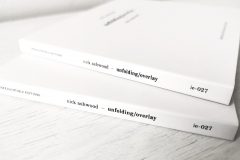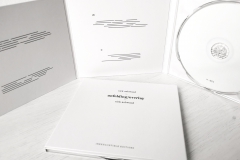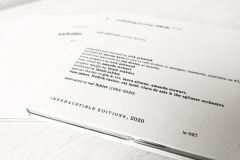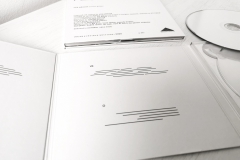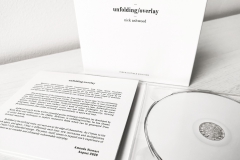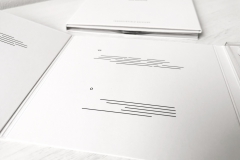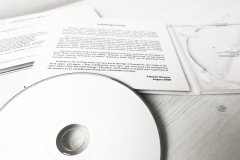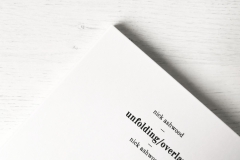Nick Ashwood – Unfolding/Overlay
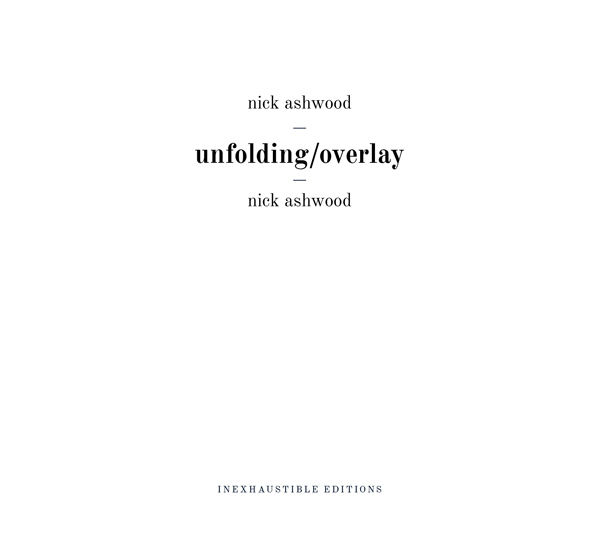
1. Unfolding/Overlay (2019) (38:30)
· Nick Ashwood: acoustic guitars
Composed and realized by Nick Ashwood
Recorded by Zarvan Kara at Reel To Reel Studios in Margate, Tasmania, Australia on 27/7/2019
Mixed and mastered by Jim Denley at Kaloola
Score graphics by Nick Ashwood
Liner notes by Amanda Stewart
Graphic design by László Szakács
Produced by László Juhász
Special thanks to Jim & Viv, Laura Altman, Amanda Stewart, Liam James, Fredrik Rasten, Cat Lamb, Clara de Asís & The Splinter Orchestra
Dedicated to Cor Fuhler (1964-2020)
unfolding/overlay
Mesmeric displacements, chordal transmutations, long tones, latent tonalities, austere, immersive, realigning the senses, clear yet unstable, ephemeral yet tangible. Listening to Nick Ashwood’s unfolding/overlay for the first time, I am struck by its restraint, its elegance, and the complexity that evolves from the most simple of elements and approaches: the tonalities generated by two, bowed, acoustic guitars.
This performance of the composition has been created ‘live to tape’ in two continuous, unedited recordings that unfold and overlay in relation to each other in real (recorded) time. This process is palpable in the listening experience, engendering an organic intimacy and vulnerability as the work develops. Using just intonation and a capo, Ashwood’s tones splinter, multiply, abstract and coalesce into a wash of colour exchanges. As the piece progresses, these washes continuously evolve into new fields of harmonicity, forming paradoxical points that unfold vertically and horizontally in space and time.
Ashwood usually works within extended guitar technique traditions (as developed by Keith Rowe and others since the 1960s). However, in unfolding/overlay, he has chosen to utilise bowing techniques to explore immersive fields which can be generated from minimal resources.
Enfolded in the shifting tones, our ears are at the edge of themselves. As I listen to the work again, and again, I hear it differently each time: new intricacies and multiplicities that I hadn’t fully absorbed emerge. The piece, itself, seems to expand one’s experience of the moment as an unstable and ultimately unknowable interplay.
Amanda Stewart
August 2020
Released: October 2020 / first edition of 300 cds
Direct purchase: Bandcamp / Discogs
GALLERY ↓
REVIEWS ↓
“Thanks to my habit of neglecting to read the sleeve notes, I only just realised that all three albums here are from Inexhaustible Editions. Also thanks to this habit, I was completely unprepared for Nick Ashwood’s solo release Unfolding/Overlay. I glanced over it, saw ‘acoustic guitars’ and figured we’d get to hear a solo approach as heard on his group improvised efforts, so my first listening was spent mostly getting over the shock of how it sounded. A steely tambura drone opens the album-length piece, which I figured was going to be the groundwork for some trancey guitar noodling until it gradually dawned on me that this was the trancey guitar stuff. Ashwood’s made this piece from two long, unedited takes of bowing on an acoustic guitar and then superimposing them. As performance, it’s a meditative experience, at once introspective yet open-minded, with the slow but purposeful drifting that comes from bringing the mind to an alert passivity through concentrated action. As a composition, the listener hears the constant weaving of bowed chords as a single, braided strand, with illusory harmonies and timbres and breathing pulses that can become either strong or frail, simple or complex, always evolving into something new of its own accord.
Just a small spoiler: the first fifteen seconds of Ferran Fages’ From Grey To Blue are silent. You might want to keep that in mind before cranking the volume. Not that the piece is loud, but it is clearly present: a forty-minute work for a full and closely-miked piano, played by Lluïsa Espigolé. Thinking back to Fages’ Un lloc entre dos records, a work for solo guitar and sine tones, and remembered that it was difficult to get a grip on: “The mind struggles to reconcile the parts into a whole”. Fages pushes the unresolved shapes of his music even further here, perhaps past breaking point. The piece falls into three parts, but in each the phrases are brief and widely separated by silences. Fages and Espigolé have collaborated over a couple of years and her playing, although described in the notes as “without emotion”, captures something tentative, even reluctant to proceed. At least there’s no sentimentality, even though the gently paced combinations of single tones and minor chords (rarely more than dyads) could lend themselves to drama. In the central section, the sounds themselves seem to thin out; when more chords return in part three everything happens more slowly. It’s described as a study in resonances and the spaces between sounds, but I’m usually pretty skeptical of pieces which make a virtue of reticence. With each successive listening, however, the sounds start to feel more tied together and playing it loud reveals the piano mechanism at work and the voids start to fill in as though they’re making some sort of connection; but as to what those connections might be, I’m not sure.
Fages is also part of the group TRUSS, playing acoustic guitar and feedback with Alejandro Rojas-Marcos on clavichord and Bárbara Sela on recorders. Todos los animales se reúnen en un gran gemido is a set of seven tracks recorded on one day in late 2019. They are apparently group improvisations but I keep hearing Fages’ methods at work. There are sustained high, keening passages as heard in his earlier piece Radi d’Or and, as the album progresses, the sounds start to break up into irresolute fragments. It’s stupid to attribute this to one musician when there are three at work. It sounds like Rojas-Marcos is using various extended techniques on his instrument, complicating the picture of who plays what when paired with Fages’ guitar. Sela’s recorder can either lead or shadow the high-pitched bowing and feedback, or otherwise derail and obstruct the continuity, forcing new approaches. The way the tracks are sequenced, the early sections are distinct and sometimes busy in that conventional group improv way, but around halfway through things become more fraught, with the music never quite succumbing to silence but always on the verge of breaking up, all the same. It’s not a comfortable experience, but it asks more questions of the listener than I originally bargained for.” / Ben Harper, Boring Like A Drill., 21 January 2021
“In my quick, first scan of these releases I made, I noticed the music of Nick Ashwood, of whom I only know he is a member of 180º. I saw on the cover he plays acoustic guitar but upon inspection, I couldn’t believe this was an acoustic guitar. Upon closer listen and reading the cover, I learned that this is all to do with using a bow to play the strings. Ashwood has two recordings, both ‘live to tape’, with no editing, and I gather from the text that he plays two guitars at the same time. So, joined on a single stereo track, this is quite the massive drone sound that you may have expected. And yet, it is at the same time quite delicate music as well. The guitar sounds like a harmonium, controlled by the feet to let air in, wheezing like an old rusty one, down at the derelict church. Throughout this single piece (just under forty minutes), the music changes minimally but noticeable. The waves are a bit longer, sometimes following in closer proximity, shifting and drifting from one place to the next. Starting carefully, building and building and then, at thirty or so minutes, it starts a slow ascend, not to be confused with a fade out. Spaces become wider, or, rather, slower, and then it ends, as abruptly as it started. This is not necessarily modern classical music, and yet, also not, strictly, improvised music. It is a most powerful release of great slow acoustic drone beauty.” / Frans de Waard, Vital Weekly, 20 April 2021
“Nick Ashwood cultivates lush harmonic interactions with two bowed acoustic guitars in just intonation during the set-length performance of their own composition on Unfolding/Overlay.
Ashwood recorded two tracks and overlaid them unedited for this realization, though their organic interplay might make it impossible to tell. It’s my understanding bowed acoustic guitar can be especially quiet too, but this recording is satisfyingly loud, ensconcing the listener in its swells and waves. By nature of the bridge and neck’s flatness, almost all the arco is rich, warm chords. Languorous bowing cadences mildly fluctuate so one chord might ebb where one flows, at the rate of inhalation, exhalation, backwash, swash. They might ascend together for especially cathartic moments. Though a track may pause for a moment, there is no silence but rather a springing coil of dynamics. These simple soundings give rise to rich complexity, radiating rainbows of dancing harmonics that join and split to create a dense ecstatic polyrhythm of singing beatings and innumerable vibratory pulses cresting in ribbed crepuscular rays. And the beatings throb and soar in one track, each track, or from the interaction of both together, a sensual coupling of two guitar’s sound unveiled in their illuminated harmonics. A music of joy and frisson.” / Keith Prosk, Harmonic Series, 1 May 2021
“Australian guitarist Nick Ashwood came our way in 2019 when he played with Amanda Stewart and Jim Denley as part of 180º on the record Submental. He’s here today with a solo set Unfolding/Overlay, which unfolds as a single track of 38:30 mins. Submental was interesting enough, but struck me as a bit unfocused, a shade too concerned with its ‘clever’ subtexts, and not creating especially memorable music. Unfolding/Overlay is a lot more accessible – it’s a solid set of droning and shifting overtones, produced by bowing two acoustic guitars. He used just intonation tuning and strapped on a capo when playing, and I think the finished work comprises two separate tape recordings which, when played back simultaneously, generate even more overtones and harmonics.
I suppose one antecedent for this would be the overlaid violin drones of Tony Conrad, although he was also trying to prove something about the grand error (as he would see it) of Western tuning scales, and through acting out his performance as a one-man thesis on two legs, created quite dissonant and challenging music that was sometimes tough to endure. Ashwood, conversely, has no bone to pick with musical history, and welcomes whatever harmonic overtones may result from his generous bowing actions, with the music mostly electing to operate around a single root chord. Amanda Stewart, who wrote the liner notes, is fine with it too, praising its ‘restraint and elegance’, and keeps finding new things in this rich drone every time she hears it.
Ashwood mimics certain elements from more hard-core minimalist composers and performers, but seems to be mostly interested in the process and doesn’t seem to have any intellectual concepts to convey, not even about duration; that said, there are graphic scores (reproduced in the CD) that presumably shaped the work.” / Ed Pinsent, The Sound Projector, 4 January 2022
RADIO PLAYS ↓
· Listening Space at Eastside 89.7 FM, Sydney, 2 November 2020
· Godbeni Imperializem at Radio Študent, Ljubljana, 12 November 2020
· The Sound Projector Radio Show at Resonance FM, London, 21 January 2022

